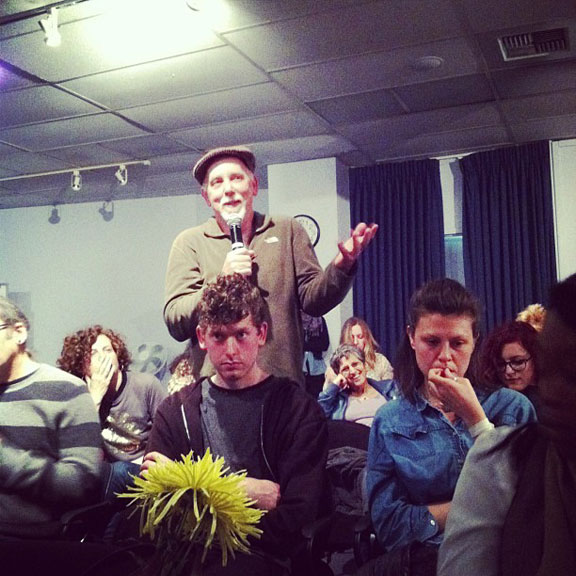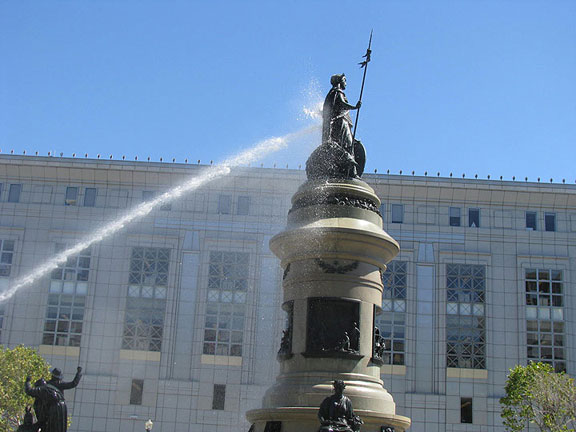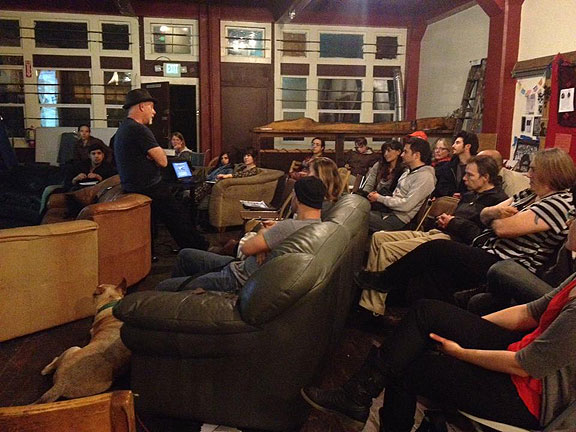I had the pleasure of seeing John Holloway last week, and meeting his compañera Eloína, an equally impressive character. They were in San Francisco thanks to Andrej Grubacic at CIIS inviting him to be a visiting scholar to present his work over three nights of lectures. I could only make the last one, where he set out to show how we are the crisis of capital. The next day we had them over for lunch, so we had a fantastic leisurely afternoon over a good meal, spending about three hours talking and laughing and enjoying the sun streaming into our dining room on a beautiful afternoon. Eloína is a computer scientist who has become an ethnobotanist, and runs a nursery in Puebla, Mexico where they live. Her work dovetailed with some other folks who passed through a year ago, who have done a lot of work on the hydrological history and future of the Valley of Mexico, so we happily shared their books.
I read John’s Crack Capitalism during the week before he arrived and really liked it. There are many places in the book where I felt a very strong resonance with the analysis I made in Nowtopia, and I was honored to discover that he quoted me in his book. Like his earlier book Change the World Without Taking Power, he is taking a very deep and basic Marxian concept, in this case the dual nature of work, and expanding it in fresh language, reworking the concept to confront and unpack the despair we often find ourselves feeling in the face of global capitalism. Part of his mission, too, is to repudiate the cul-de-sac of traditional Marxism with its elision of the dual nature of work in favor of an emphasis on the struggle between capital and labor. Holloway emphasizes again and again throughout his books that capital and abstract labor are two parts of the same thing. If your radical politics starts from what you do as wage-labor, as abstract labor, you are already trapped in the logic of capital. The point is to fight against abstract labor, against the subordination of our “doing” (whatever we may choose to do) to the logic of money and markets.
The ambition of Crack Capitalism is impressive. He situates most of the divisions and schisms facing contemporary radicals in the subordination of subjectivity to abstract labor. It can seem a bit dense and complicated at moments, but overall I want to congratulate him on a well-done effort to bring these concepts out into the light of day and making them quite accessible and clear. Here is a quote where he summarizes his critique of identity politics:
Identification or reification is an enormously destructive force in everyday struggle. We give our protests a name, a label, a limit. Our struggle is the struggle of women, of gays, of workers, of the unemployed, it is the struggle for indigenous rights, for uncontaminated food, for peace. It may be that we are at least vaguely aware that our struggles are part of a wider whole, perhaps even that they are the product of the way in which human doing is organized in the world, but, precisely because that form of organization seems permanent (‘it is easier to imagine the end of the world than the end of capitalism’), we enclose our struggles within limits, within an identity. And so we have a world full of protest, a world of people aware in some way that there is something fundamentally wrong with the way society is organized, and yet so many walls separating these struggles, so many dykes preventing them from flowing into each other. And all these walls are identifications, the grand framework identification of the capitalism-that-is-and-always-will-be, and the lesser identifications of ‘we are gay, we are women, we are indigenous, we are Basque, we are Zapatistas, we are anarchists, we are communists’. And all these identities become so easily the basis for sectarianism, the perennial self-destruction of the left that makes life easy for the police. Far more effective than any system of secret police, identity is the reproduction of capital within anti-capitalist struggle. (p. 114)
His book’s title indicates the frame of inquiry Holloway is following. He sees cracks in the façade of capitalist society that grow from all sorts of non-subordination (to abstract labor), and occasionally from insubordination. By the end of the book he acknowledges that none of the myriad activities and initiatives are perfect, or even necessarily guaranteed to succeed. Our obsession with being pure or uncompromised is one of the ways we paralyze our own capabilities:
There is never any purity in these experiments, thank goodness. All are contradictory. The dedicated revolutionary who abandons his children to go and fight for the great cause, the indigenous organization that accepts funds from a church dedicated to subordination and misogyny, the radical professor who participates in the quantitative measurement of students’ work, the cooperative that sells its products on the market, the car worker who spends most of his time producing objects and that kill and contaminate and then organizes a community garden in the evenings and at weekends, the student who organizes demonstrations but does not question the categories of the subject she is studying: all, all are self-contradictory, we are all involved in the re-creation of the social relations we are trying to overcome. It cannot be otherwise in a capitalist society. The movement of doing is not a pure movement, but a moving in-against-and-beyond labor. There is no purity here: we try to overcome the contradictions, we rebel against our own complicity, we try in every way to stop making capitalism, we try to direct the flow of our lives as effectively as possible towards the creation of a society based on dignity. We are part of the social flow of rebellion, and in this flow there is no room for rigidities and hard lines. The concepts of correctness and betrayal, its complement that is so rooted in the culture of the left, are obstacles to the flow of rebellion. To create rigidities and dogmas and ‘we do not talk to them because they are reformists’ and ‘we will have nothing to do with them because they drink coca-cola’ and ‘we will not cooperate with them because they are sectarian’, is to take an active part in the freezing of the flow of rebellion, to reproduce the definitions and classifications and fetishes of capitalist thought. (p. 257)
I admit I was really happy to read this bit on patience. I’ve spoken publicly many times about “radical patience,” characterizing it very similarly to how he does it here:
Creating another society cannot be just a question of events and intensities. Beyond the puncturing of duration, beyond the discontinuities of excess, there is also the question of creating other social relations, of doing things in a different way, at a rhythm of our own choosing. Probably we need to think of revolution in terms of both temporalities: the temporality of rave-and-rage, performance-and-dance, and the temporality of patient creation, of gardening-and-weaving. This is not the old virtue of revolutionary patience, based on the idea that we must wait until objective conditions are ripe. This is a different sort of patience that says ‘no waiting, let’s get on now with constructing a different world, but it is not something that can be created in an explosion of fury, it requires and always will require a process of patient creation’. (p. 238-39)
Before I read Crack Capitalism I was perusing George Katsiaficas’s magisterial history Asia’s Unknown Uprisings in preparation for his appearance at our Talks series in March. I went straight to the chapter in Volume 1 (South Korean Social Movements in the 20th Century) about the Gwangju Uprising in May 1980. I remember well rushing to buy a New York Times during those late May days that year, trying to get news about the uprising underway in Gwangju, South Korea. Practically the entire population of the city of 700,000 threw out the military, then a state-of-the-art, fully supplied ally of the U.S. under the brutal dictatorship of Chun Doo-hwan. In Katsiaficas’s telling, the amazing bravery of bus drivers, taxi drivers, and countless students, housewives, factory workers and others in overcoming the extreme brutality and murderous onslaught of crack paratroopers in armored vehicles is just stunning. Then, during the week of May 21-27 they held their city against a relentless effort by the dictator to suppress them militarily, while the revolt spread to the rest of the surrounding region in the southernmost part of Korea. Inside Gwangju daily assemblies of up to 100,000 people made democratic decisions and organized their armed resistance. Part of why this could work was that as a marginalized and downtrodden population within South Korean society, the people of the area still had an intact civil society rooted in generations of shared life. Here is his analysis of what was going on:
Dubbed the absolute community, the organic solidarity of participants in the Gwangju Commune embodies what I consider to be humans’ instinctual need for freedom—grasped intuitively—an unconscious need that was sublimated into collective expression during the uprising. The sudden emergence of hundreds of thousands of people occupying public space; the spread of the revolt from one district to another in South Jeolla; the intuitive identification of hundreds of thousands of people with each other and their simultaneous belief in the power of their actions; the self-organization of the Citizens’ Army; and the suspension of normal values like competitive business practices, criminal behavior, and acquisitiveness are all dimensions of what I call the “eros effect.” —George Katsiaficas, Asia’s Unknown Uprisings Vol. 1: South Korean Social Movements in the 20th Century (PM Press: 2012)
I love this description and the labels “absolute community” and “eros effect.” I felt that eros effect in the May 21, 1979 “White Night Riot” here in San Francisco, and many times since in Critical Mass rides and during the Nov. 2 General Strike last year during Occupy Oakland, and so on. It is something we yearn for, something we seek out wherever we can find it. No matter what, it’s not something we can just conjure up through will power or wishful thinking. It appears when it appears, and it requires great nurturance and patience to keep it alive and expanding. But the best part of it is the effect it leaves behind in the shared imagination of the people who have experienced it. It is the bedrock from which further initiatives can grow.
Tahrir Square in Egypt is another recent case in point. While reading Crack Capitalism I was also reading Cairo: My City, Our Revolution (Bloomsbury Publishing, London: 2012) by Ahdaf Soueif, a lovely literary first-hand account of the heady days of the uprising against Mubarak and the Egyptian state. We know now that it hasn’t reached its goals yet (in fact the Egyptian revolution is facing serious obstacles as I write, though steady demonstrations and protests continue to rock Cairo and other cities there). Soueif acknowledges as much several times in her beautiful book, saying that we reading her words know more than she does as she is writing them back in 2011 or early 2012. But she is there in Tahrir Square and brings us in with her to taste that eros effect in full bloom during those special weeks:
All the ills which plagued our society in the last decades have vanished overnight. Young men, who a month ago could have been thought a menace to any woman on the street, were chivalry itself. People offer each other biscuits, dates, water. People chat, people pick up litter. We revel in the inclusiveness, the generosity, the humor that come so easily to us. Students, businessmen, waiters, academics, farmers, civil servants, unemployed—we are all here together, all doing what we’ve not been able to do for decades: each and every one is speaking, acting, expressing themselves and insisting on being counted. (p. 56)
One hundred pages later, after some setbacks but as Mubarak is finally giving way and leaving office, she fights her way through crowds and traffic to make it into the Square (or the Midan as the Egyptians call it).
…once you’re inside, the Midan is amazing. Even the light in here is different, the feel of the air. It’s a cleaner world. Everything’s sharper, you can see the leaves on the trees. Badly lopped, they’re trying to grow out. Everyone is suddenly, miraculously, completely themselves. Everyone understands. We’re all very gentle with each other. As though we’re convalescing, dragged back from death’s very door. Our selves are in our hands, precous, newly recovered, perhaps fragile; we know we must be careful of our own and of each other’s.
The Midan is sparkling clean. The rubbish is piled neatly on the periphery with notices on it saying ‘NDP Headquarters’. The fence of corrugated iron stands again around the mystery building site and screens newly constructed washrooms. Lamp posts have put out wires so that laptops and mobiles can be charged. The field hospitals provide free medical care and advice for everyone. A placard reading ‘Barber of the Revolution’ guides you to a free shave and a haircut. A giant transparent wall of plastic pockets has gone up. The shabab sit next it. People tell them jokes and they draw or write them and slot them into the pockets; a rising tide of jokes and cartoons. A Punch and Judy show is surrounded by laughing families. A man eats fire. There’s face-painting and music and street theatre and a poetry stand. (p. 159)
I haven’t been feeling very inspired lately. The absurdity of living through a second full-on tech boom with its concomitant obliviousness and entitlement, its ethnic and social cleansing scouring our neighborhood, threatening us too with the tidal wave of money displacing all in its wake, is disheartening on a daily basis. But I was glad to find solace in these remarkable books, in extracting myself for some hours from the nose-to-the-ground worries to remember that the flow of history is much bigger than our little drama here in the Mission. We have our own fights, to be sure, but the bigger effort to change how we live is ongoing, and takes place in fits and starts across time and space. Our allies are everywhere and it’s easy to overlook how much has happened in recent years when despairing about what is happening in this immediate moment in my immediate surroundings. So take heart! I’m going to give the last word to John Holloway:
Our struggle is to open every moment and fill it with an activity that does not contribute to the reproduction of capital. Stop making capitalism and do something else, something sensible, something beautiful and enjoyable. Stop creating the system that is destroying us. We only live once, why use our time to destroy our own existence? Surely we can do something better with our lives. Revolution is not about destroying capitalism, but about refusing to create it. To pose revolution as the destruction of capitalism is to reproduce the abstraction of time that is so central to the reproduction of capitalism: it is self-defeating. To think of destroying capitalism is to erect a great monster in front of us, so terrifying that we either give up in despair or else conclude that the only way in which we can slay the monster is by constructing a great party with heroic leaders who sacrifice themselves (and everyone around them) for the sake of the revolution… To pose revolution as the destruction of capitalism is to distance it from ourselves, to put it off into the future. The question of revolution is not in the future. It is here and now: how do we stop producing the system by which we are destroying humanity? Rephrasing the question of revolution as stop making capitalism does not give us the answers.















ha! I actually sent them copies of our two Critical Mass books, but predictably they haven’t responded… Critical Mass has always been easy to experience as a basically apolitical public celebration, but it nevertheless insinuates itself into one’s imagination in terms of a radically transformed public space, the capacity of “strangers” to self-organize a transgressive use of urban space, etc…. how it affects multimillionaire NBA stars, I have yet to know…
Strong post, as always.
I wondered what you thought of this little note I read of in a Men’s Journal article, on a certain Lebron and D-Wade being ardent Critical Massers:
http://www.huffingtonpost.com/2012/09/29/dwyane-wade-critical-mass-gabrielle-union_n_1925176.html
Down with the Cause?
Muchas gracias, me ha encantado la forma de exponerlo, lo recomiendo mucho. Besos!!
I got so much out of attending two of Holloway’s lectures, thanks to your mentioning them in you newsletter. And I enjoyed this post as well – thank you.
Listening to Holloway speak gave me some relief from some of the isolation, alienation and inadequacy I usually feel (but was only vaguely aware of)as I live, work and go about my business, thinking that my discontents and frustrations are all my own. His ideas, poetically expressed, are beautiful.
Great post, excellent quotes. “Revolution is not about destroying capitalism, but about refusing to create it.” particularly resonated.
In the first quote, where it says “…so many walls separating these struggles, so many dykes preventing them from flowing into each other,” did he really write “dykes” instead of “dikes”? Great pun or great typo, either way!